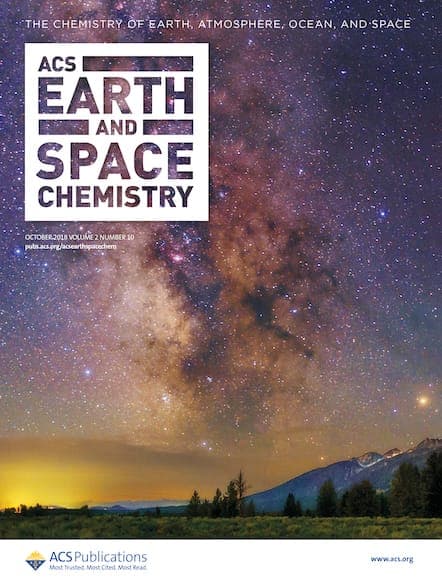It has been more than a year since ACS Publications launched its 50th journal: ACS Earth and Space Chemistry. The impetus for the creation of this journal was to provide a publishing platform for research focused on the application of analytical, experimental and theoretical chemistry to understanding the Earth and space. We intended that the […]

We are pleased with the positive response we have received from the Earth and space chemistry research community, and we thank both the authors and the reviewers who have supported the journal from its inception. A few statistics from our first year: in our first 14 issues (March 2017 – April 2018) we published more than 100 articles, and more than 1000 journal pages. Our median manuscript processing time was 8.6 weeks from receipt to acceptance, and we have been indexed in the Web of Science since July 2017. The top five countries for numbers of manuscripts published are (in decreasing order) the U.S., China, France, the United Kingdom and Canada. Our January, 2018 issue is free to access, and we encourage you to explore this issue.
This month we are publishing our first Special Issue, entitled “Global Cycling of Mercury.” This issue was linked to the recent International Conference on Mercury as a Global Pollutant under the conference theme: “How is global mercury cycling changing in response to perturbations?” We seek to provide a balance in our Special Issues between the various areas of research that we cover and will focus future Special Issues on topics from each domain of the journal.
In the near future, we plan to solicit additional review papers and are excited to see how well received our first review, “ Pathways to Meteoritic Glycine and Methylamine,” has been since being published in our inaugural issue, maintaining its position as one of the top five most-read articles. Some of our other most-read articles include:
Mercury Pollution in Amapá, Brazil: Mercury Amalgamation in Artisanal and Small-Scale Gold Mining or Land-Cover and Land-Use Changes?
ACS Earth Space Chem., 2018, 2 (5), pp 441–450
DOI: 10.1021/acsearthspacechem.7b00089
***
Microbes Facilitate Mineral Deposition in Bioelectrochemical Systems
ACS Earth Space Chem., 2017, 1 (5), pp 277–287
DOI: 10.1021/acsearthspacechem.7b00042
***
Criegee Intermediate–Alcohol Reactions, A Potential Source of Functionalized Hydroperoxides in the Atmosphere
ACS Earth Space Chem., 2017, 1 (10), pp 664–672
DOI: 10.1021/acsearthspacechem.7b00108
***
The Role of Organic Aerosol in Atmospheric Ice Nucleation: A Review
ACS Earth Space Chem., 2018, 2 (3), pp 168–202
DOI: 10.1021/acsearthspacechem.7b00120
***
Nitrogen Isotopic Fractionation in Ammonia during Adsorption on Silicate Surfaces
ACS Earth Space Chem., 2017, 1 (1), pp 24–29
DOI: 10.1021/acsearthspacechem.6b00006
***
Composition and Evolution of Frozen Chloride Brines under the Surface Conditions of Europa
ACS Earth Space Chem., 2017, 1 (1), pp 14–23
DOI: 10.1021/acsearthspacechem.6b00003
Besides being our most-read articles, this group of papers also represents the wide range of interdisciplinary research covered by the journal.
We are pleased with the strong overall performance of ACS Earth and Space Chemistry during its first year. Nevertheless, we see considerable room for growth in the number and breadth of manuscripts that we can handle and we encourage additional submissions. We would like to see a healthy balance between the scientific domains that we publish in, and so in the future, we especially hope to increase submissions focusing on high-temperature geochemistry and analytical geochemistry.
